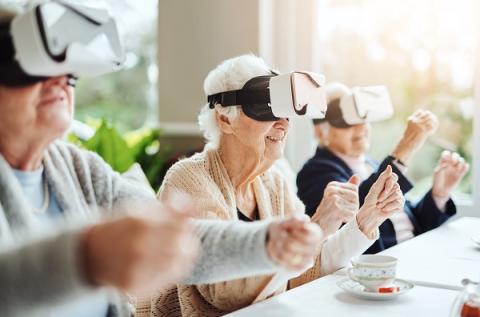AgeTech 101
The number of people age 60 and older is growing faster than any other age group, so it’s no wonder that there is a growing market for technology aimed specifically at that group. The AARP estimates that technology spending by adults age 50 and older will be $118 trillion by 2050.
No matter what your age, we all have a vested interest in ensuring that as many older adults who want to age in place can do so safely and independently. All “consumers benefit from the continuing innovation which ultimately improves their everyday lives,” says Jo Ann Jenkins, the CEO of AARP.
Technology specifically for older adults, often referred to as gerontechnology or agetech, encompasses the use of various solutions to address the needs, challenges, and preferences of the aging population. Examples of agetech include:
Assistive devices: Devices that help older adults with daily tasks, such as hearing aids, mobility aids (like walkers and canes), and devices for vision enhancement.
Telehealth and remote monitoring: Telehealth platforms and remote monitoring systems allow healthcare professionals to remotely monitor patients’ health conditions, enabling seniors to receive medical care and guidance without needing to travel. The COVID-19 pandemic certainly boosted demand for such technology. Even as the public health emergency is in our collective rearview, telemedicine is here to stay. Remote monitoring can also help caregivers keep an eye on older adults even while they are away.
Smart home technologies: Smart home devices, like smart thermostats, automated lighting, and voice assistants, can make daily living easier for older adults by providing greater control over their environment. Motion-detecting lights are available for indoor use. Smart appliances can alert someone when a stove is left on unattended, for example, and turn off the appliance automatically.
Wearables: Wearable devices like smartwatches can track vital signs, physical activity, and sleep patterns, enabling older adults to monitor their health in real-time. There’s even a wearable that can detect how full the bladder is and remind an older adult to use the restroom.
Fall detection systems: These systems use sensors to detect falls and automatically alert caregivers or emergency services, increasing the safety of seniors living alone. A smart scale can measure balance and assess the risk of falls.
Medication management: Apps and devices like automatic medication dispensers help older adults manage their medication schedules, including reminders and alerts.
Social connectivity tools: Video conferencing platforms, social media, and communication apps help older adults stay connected with family and friends, reducing feelings of isolation. Virtual reality is being used in long-term care settings for entertainment and skill building. It’s also helping Alzheimer’s patients with “reminiscence” therapy.
The goal of aging technology is to improve the quality of life for older adults, while also addressing some of the challenges that come with aging. This field continues to evolve as technology advances and our understanding of the needs of the aging population deepens. While we are a long way off from having our own personal care robot like Baymax from “Big Hero 6,” the future of aging technology is bright.
